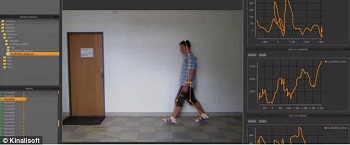Computer scientists in the Czech Republic have produced the software to analyse a person’s gait from CCTV footage – and it can identify someone in as few as four steps. It tracks the footage of a person to separate their shadow from the background. This brings its own set of challenges as the background can have complicated patterns and shadows. It is then able to extract additional information from the person’s outline and the angle of their joints to find their unique gait, almost like a fingerprint.
Such analysis could provide useful in situations where police have clear footage of a suspect but their face is covered or out of shot. Radek Štourač, a computer scientist from the Czech Republic, said: ‘Our system can help recognise such people and trace them as they move in front of cameras.’ Speaking to Horizon magazine, the computer scientist described how software produced by his company Kinalisoft, based in the Czech Republic’s second largest city, Brno, could help identify suspects who have been caught on film but can’t be identified from their face.
The Gait Biometrics 3 project is aimed at improving this level of accuracy and producing a model of the software and to assess its commercial potential and technical feasibility. Horizon magazine reports that the software gets it right 99 times out of 100, with just a 0.8 per cent chance of it confusing a person’s normal walk for someone else, and it requires no additional cameras or sensors. Estimates put the number of CCTV cameras in the UK at more than six million, which makes for one camera for every 11 people.
Researchers around the world are already working to link networks of cameras, developing algorithms which identify and track people as they move between cameras. The cameras can first identify a person in a video frame, then follow that same person across multiple camera views – and can even analyse live footage from drones. Researchers at the University of Washington, who have been developing a system since 2014, believe it could save hours of sifting through CCTV footage – and even revolutionise GPS systems.








